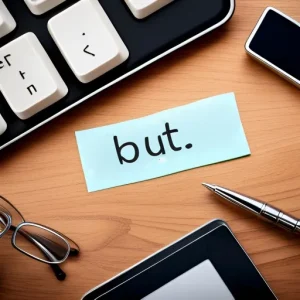 Often, as per the saying, “I burnt through the midnight oil” to get ahead on my work week and start with fresh goals for my morning, as per success method #1 from @Rob Dance
Often, as per the saying, “I burnt through the midnight oil” to get ahead on my work week and start with fresh goals for my morning, as per success method #1 from @Rob Dance
“BUT”, later, my day took a turn, as often it can when freelancing or contracting. A client called, excitedly sharing that a major sponsor for an upcoming event was extremely pleased with “everything so far”…“but”.
By the tone of voice, you know that feeling when you’re waiting for that one little word to change the course of the conversation. That word is the inevitable “but.” Doesn’t it seem ironic how frequently sentences conclude with that seemingly small yet powerful word, introducing a twist that can throw off a day or a week? This specific customer delivered “but” would set me back two days of invested work.
This situation led me to ponder: Why is the word “but” so prevalent in our conversations? Does the prevalence of “but” stem from people’s reluctance to be decisive? Having to make a decisive decision made me reflect on my days as a flight instructor. Being firm and strong is crucial when in the air and flying an aircraft, but it was a different story in the flight school classroom. As a flight instructor on the ground, I had to build up my students, starting with positive feedback before addressing their mistakes. I.e. “Your take off today was smooth, and your communication with the tower was excellent; you will need to ease back on the throttle next time. While In the aircraft, this equated to me quickly pulling back the throttle before my student overshot the runway end as they chatted with the ground tower on the wrong channel.
Are we all guilty of finding it difficult to deliver the news in a direct manner? Are we all trying to frame a sentence in its ‘politically correct form,’ i.e. “You look great in that outfit, but perhaps you may want to consider something else”, rather than “You look terrible, you should not be seen dead in that outfit”
An acquaintance of mine posed this regarding the “BUT matter:
I would equate it to ‘sleeping beauty’: delivery of a juicy apple laced with a sleeping agent. Okay, it may not be so poisonous, but I hope the readers get my point: a negative statement disguised as a positive statement. I do not adhere to the opinion that possible indecisiveness causes this type of “but” phrasing; it goes deeper than that.
In my opinion and only qualifying from my observations and experiences, I sincerely think it relates to human conditioning based on our personal background and conditioning – nature and nurture – with the main operative word to focus on the term “conditioning”.
Based on studies made (by Jack Canfield, self-esteem expert), it takes five positive statements to counter one negative statement. An average child hears 432 negative comments daily but only 32 positive messages daily. Research shows further that words hurt 80% of people, and only about 20% of children and adults can handle put-downs without emotional pain or psychological damage (data from California Task Force for Personal and Social Responsibility). As a result, we are “conditioned” since childhood to communicate as much as possible with some polite “semblance” of “positive” delivery when communicating.
Ironically, even with our years of conditioning, our inbuilt human alarms allow us to pick up this negative comment through body language and nonverbal cues. Contrary to what societal conditioning originally intended, one automatically reacts, consciously or subconsciously, by immediately raising our guard and being on the defensive, waiting for the predictable “BUT” followed by the critical negative statements afterwards.
So, how do we counter-measure this negative statement and find a mutually beneficial way for positive communication flow? I suggest paraphrasing a person’s or client’s statement back to them via a positive reply through the exchange of words “BUT”, “HOWEVER”, or “YET” with the words “AND” & “WITH”.
For example, the following statement is a negative comment if this was said by a client, “I think your presentation was great, BUT I don’t like the look of this logo.”
Replacing the word “but” with “and” changes the whole tone of the sentence. Then, paraphrase the sentence back to a client in this manner: “Thank you for your feedback, “AND” clarifying your comment, the presentation design is great so far “AND” that you would like me to review the logo further to your requirements?”
Hopefully, it will have a domino effect, and people will, subconsciously or consciously, reciprocate positively, too. If not, at the very least, with practice and time, you will have reconditioned your communication delivery and reciprocations to negative statements, representing a significant competitive advantage in successful communication.
Anyone care to make comment? ,this was great… but! 😉